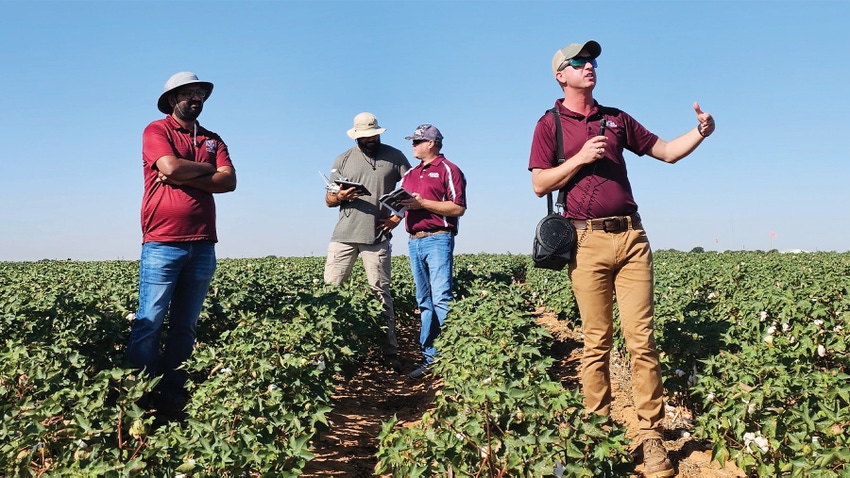
The advantages of maintaining vegetation in crop fields year-round are numerous and well-known. Making it work in a region with limited moisture and extreme temperatures poses significant challenges.
It can be done, said Joseph Burke, assistant professor, cropping systems and weed science, Texas A&M AgriLife Research and Extension, Lubbock.

Joseph Burke, assistant professor, cropping systems and weed science, Texas A&M AgriLife Research and Extension, Lubbock. (Photo by Shelley E. Huguley)
“We know that the number one way to limit soils from blowing in West Texas is to have something growing,” Burke said at the Texas Plant Protection Association annual conference in Bryan. “Can we get anything to grow?” he asked. “We can and we can get some pretty substantial amounts of herbage mass growing in these systems, utilizing only winter precipitation.”
Evaluating regenerative agriculture systems is a key of ongoing research effort at the research center in Lamesa, about an hour south of Lubbock, “where I conduct all of my research,” Burke said. “Wayne Keeling planted his first cover crop trial in Lamesa in 1998.”
Burke offered some historical perspective on the ravages of wind erosion on the High Plains. The Dust Bowl, he said, forced changes in cropping practices, changes that have been successful in spite of recurring erosion events.
“We have reduced wind erosion by about 80% since the Dust Bowl, but we still experience wind erosion because of the climate that we live in,” Burke said. “We are bound to that climate, so how do we develop resiliency within that system?”
He said Keeling began to establish a system comparing continuous no-winter-tillage cotton with conventional tillage and winter fallow to a no-till with rye cover crop planted at 40 pounds to the acre (the NRCS recommendation).
Mixed cover
Keeling added a new wrinkle in 2014. “He split the rye cover crop plots in half and added a mixed species cover. In the late twenty 2010s folks were interested in what mixed species could do. Adding legumes would put nitrogen in the system to offset carbon from the rye.”
The cover mix included 50% rye, 33% Austrian winter pea, 10% hairy vetch, and 7% radish.
“What percentage of the legumes do you think got established in those systems?” Burke asked. “Zero is a good number. Every year we had 99.8% rye in our mixed species system.”
Burke said a lot of variability exists for the stability of these systems. “Rye outperforms that system, probably because of the higher seeding rate.
“We also didn't see that the cover crop translated to a yield improvement. The conventional tilled system is more stable relative to both of those cover crop treatments. No-till with rye performed the worst. In none of the years did our cover crops outperform the conventional till system.”
Burke said the difference is moisture.
“In 2018 to 2019 and 2019 to 2020, a significant amount of soil moisture was taken up by the cover crop. However, after we terminate the cover crop, we see a significant increase in the amount of stored soil compared to the conventional till system.
“We are using that water, but an increase in organic matter over the time cover crops are in place increases moisture storage capacity.”
The problem, Burke explained, is that even though the cover crop doubles the amount of water storage capacity, the amount of precipitation in these systems does not increase without changes in rainfall or irrigation.
“We have to make up the difference with irrigation or a rainfall event,” he said. “These systems are great when we have 6-inch-an-hour rainfall events like we sometimes get in West Texas. This system takes up more of that 6-inches of rain than our conventional till system. And at a half-a-percent slope, the water does not run off, it just moves between the rows.”
Burke says before the cover crop is terminated less water remains in the no-till system than in a conventional tilled system.
“Once we terminate, water increases at a greater rate,” he said. “We're capturing and storing more water in the no-till system than in a conventional till system. That water remains throughout the growing season, and plants have access to it. Not only are we increasing water capacity, but we're also increasing availability of water.”
Cotton/wheat/fallow
Ph.D. student Chris Cobos (supervised by Katie Lewis, associate professor, soil chemistry and fertility, Texas A&M AgriLife Research, Lubbock) is testing a third system. In addition to the conventional till system with winter fallow and the no-till system with a rye cover, he added a cotton/wheat/fallow rotation, a common practice on the High Plains because it provides 11 months to capture soil moisture during the fallow period following wheat.
Stored water can be available to the subsequent cotton crop. “We are seeing an increase in the amount of water available to these systems,” Burke said. “And that does translate to yield in both a dryland and an irrigated system.”
Nutrition timing
Nutrition timing plays a role, too, he said. “We're adding a bunch of carbon with the organic matter. When we add carbon, we have to balance it with nitrogen to decompose the carbon.
“We looked at these three cropping systems to evaluate nutrition:
continuous cotton system with winter fallow
continuous cotton, no tillage with a rye cover crop
cotton-wheat fallow rotation
“We shifted one fertilizer application from later to earlier in the season to offset the carbon increase. By moving the nutrient application earlier in the season following a cover crop, we increased cotton lint yields by 16% and 19%, compared to a conventional tilled system.
“We see a 50% increase in cotton lint yield following a fallow period in the wheat compared to the conventional till system. With a 50% increase in cotton/wheat or cotton revenue in the cotton/wheat fallow system, we see a 77% increase in gross margins compared to the conventional tilled system.”
Burke said one stickler is the fallow year with no income. “
You still have to pay taxes every year, right? So, we have a pilot study in Dawson County, working with tax assessors to determine if we can delay tax payments to only a cotton-yielding year. We’re also considering what does it does to county budgets. We are looking at communities, the environmental sustainability, and the economic sustainability of these systems.
“I have talked about the myths of why cover crops don't work well for increasing yield, but they do,” Burke said.
“We see ecosystem benefits, something we’re most proud of. Over 20 years, from 1998 to 2018, we doubled soil organic carbon in no-till systems. Over those 20 years, organic carbon improved from .2% to .4%. That doesn't sound like much, but it represents a lot of water storage capacity.
“Also, carbon markets pay about $15.00 an acre to implement a cover crop in our region. Consider how much carbon we have sequestered over 20 years in this system, about 0.14 tons of carbon per acre per year. At current carbon valuation, that comes to about $4 a year in carbon.”
Burke said farmers who utilize some of the government insurance or cover crop assistance programs in the region could add value to the system.
About the Author(s)
You May Also Like






